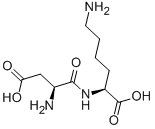TRYPSINOGEN
- CAS NO.:9002-08-8
- Empirical Formula: C39H55N9O17
- Molecular Weight: 921.9
- MDL number: MFCD00466939
- EINECS: 232-651-3
- SAFETY DATA SHEET (SDS)
- Update Date: 2023-04-23 13:52:06

What is TRYPSINOGEN?
The Uses of TRYPSINOGEN
Trypsinogen from bovine pancreas is suitable for use in:
- the secondary structure analysis of proteins in H2O solution using single-pass attenuated total reflection Fourier transform infrared (ATR-FT-IR) microscopy
- tuning and calibration of electrospray ionization quadrupole time-of-flight (ESI-Q-TOF) mass spectrometer
- the secondary structure analysis of proteins by infrared (IR) spectroscopy
- SDS-PAGE as a molecular weight standard (24kDa)
General Description
Trypsinogen is a proenzyme (zymogen) that is activated to form trypsin. It is synthesized in the pancreas and activated by enterokinase once it reaches the lumen of the small intestine. Bovine trypsinogen is a single polypeptide chain of 229 amino acids that is cross linked by six disulfide bridges. Enterokinase cleaves a hexapeptide to from the NH2 terminus of trypsinogen at the Lys6 - Ile7 peptide bond and activates it. Trypsin, thus formed, autocatalytically activates more trypsinogen to trypsin. This native form of trypsin is called β-trypsin, which undergoes autolysis at Lys131 - Ser132 resulting in α-trypsin that is held together by disulfide bridges. Trypsin is a serine protease with His46 and Ser183 at the active site. The pH optimum of trypsin is 7 - 9.
Biochem/physiol Actions
Hereditary pancreatitis was shown to be caused by a Arg-His substitution at residue 117 of trypsinogen causing auto-activation of trypsinogen to trypsin.
Properties of TRYPSINOGEN
| storage temp. | 2-8°C |
| form | essentially salt-free, lyophilized powder |
Safety information for TRYPSINOGEN
| Signal word | Danger |
| Pictogram(s) |
 Health Hazard GHS08 |
| GHS Hazard Statements |
H315:Skin corrosion/irritation H319:Serious eye damage/eye irritation H334:Sensitisation, respiratory |
| Precautionary Statement Codes |
P302+P352:IF ON SKIN: wash with plenty of soap and water. P305+P351+P338:IF IN EYES: Rinse cautiously with water for several minutes. Remove contact lenses, if present and easy to do. Continuerinsing. |
Computed Descriptors for TRYPSINOGEN
New Products
(S)-3-Aminobutanenitrile hydrochloride 4-Methylphenylacetic acid N-Boc-D-alaninol N-BOC-D/L-ALANINOL Tert-butyl bis(2-chloroethyl)carbamate 3-Morpholino-1-(4-nitrophenyl)-5,6-dihydropyridin- 2(1H)-one Furan-2,5-Dicarboxylic Acid Tropic acid 1-Bromo-3,5-Di-Tert-Butylbenzene S-2-CHLORO PROPIONIC ACID ETHYL ISOCYANOACETATE 2-Bromo-1,3-Bis(Dimethylamino)Trimethinium Hexafluorophosphate 4-IODO BENZOIC ACID 3-NITRO-2-METHYL ANILINE 1-(2,4-DICHLOROPHENYL) ETHANAMINE (2-Hydroxyphenyl)acetonitrile 4-Bromopyrazole 2-(Cyanocyclohexyl)acetic acid 4-methoxy-3,5-dinitropyridine 1-(4-(aminomethyl)benzyl)urea hydrochloride 2-aminopropyl benzoate hydrochloride diethyl 2-(2-((tertbutoxycarbonyl)amino) ethyl)malonate tert-butyl 4- (ureidomethyl)benzylcarbamate Ethyl-2-chloro((4-methoxyphenyl)hydrazono)acetateRelated products of tetrahydrofuran








You may like
-
 Trypsinogen from bovine pancreas CAS 9002-08-8View Details
Trypsinogen from bovine pancreas CAS 9002-08-8View Details
9002-08-8 -
 Trypsinogen, PMSF treated from bovine pancreas CAS 9002-08-8View Details
Trypsinogen, PMSF treated from bovine pancreas CAS 9002-08-8View Details
9002-08-8 -
 1975-50-4 98%View Details
1975-50-4 98%View Details
1975-50-4 -
 2-HYDROXY BENZYL ALCOHOL 98%View Details
2-HYDROXY BENZYL ALCOHOL 98%View Details
90-01-7 -
 2-Chloro-1,3-Bis(Dimethylamino)Trimethinium Hexafluorophosphate 221615-75-4 98%View Details
2-Chloro-1,3-Bis(Dimethylamino)Trimethinium Hexafluorophosphate 221615-75-4 98%View Details
221615-75-4 -
 61397-56-6 CIS BROMO BENZOATE 98%View Details
61397-56-6 CIS BROMO BENZOATE 98%View Details
61397-56-6 -
 14714-50-2 (2-Hydroxyphenyl)acetonitrile 98+View Details
14714-50-2 (2-Hydroxyphenyl)acetonitrile 98+View Details
14714-50-2 -
 118753-70-1 98+View Details
118753-70-1 98+View Details
118753-70-1